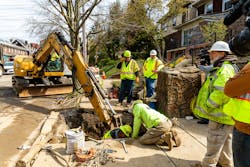Too many communities are in a state of water crisis. Over two million Americans lack access to water and sanitation in their homes, and many more are served by systems that are not providing safe and reliable service. Inequities in infrastructure reinforce other inequities. Race and place are the most predictive indicators of exposure to environmental hazards, which is equally true when it comes to water systems. Where a person lives determines whether their water will be safe, whether they will be able to afford their water bills, whether their home and community can withstand flooding or drought, and if they have running water at all.
With the new administration in 2020 came a wave of hope and opportunity to address these inequities. Signed into law in 2021, the Infrastructure Investment and Jobs Act (IIJA) is the largest federal investment in water infrastructure in 50 years, laying the vital foundation for investments long needed in water and for communities. The IIJA provides five years of boosted infrastructure investments with which to reimagine the infrastructure investment paradigm, with $55 billion dedicated specifically for water.
While the IIJA is a historic investment, it is not enough to meet the nation’s current water infrastructure needs or prepare for the future. In 2020, the Value of Water Campaign and the American Society of Civil Engineers estimated that the U.S. needs to invest an additional $109 billion per year in water infrastructure, over expected spending, for the next 20 years to close the water infrastructure gap. The IIJA investment covers only a small fraction of this overall need. Advocates will have to build the case for Congress to provide more funding in the future; however, even with greater funding, many current water infrastructure investment approaches have serious limitations.
The current federal and state system of water infrastructure funding is designed to improve the way we move, treat, or store water, wastewater, or storm water. It is not inherently designed to target disparities in infrastructure quality and service.
Addressing these disparities requires reimagining the dominant ways water is funded in the U.S. At the same time, the water investments coming through the IIJA are slated to flow through long-standing channels, so advancing equity will require innovation within this existing system. Many communities will need to prioritize traditional capital projects and models of project delivery, but this extra funding is also an opportunity to embrace new types of transformational investments and projects.
The challenge is both immediate and long-term: to make the most of the five-year opportunity at hand while exploring funding system reforms and building the will for sustained and sustainable water investment. It is time to prioritize water equity, climate action, economic opportunity, and One Water in water infrastructure and capital projects.
Equitable Infrastructure Implementation
Sufficient federal funding is essential for financing equitable infrastructure projects and programs, and it is up to state, regional, and local water stakeholders to ensure this funding supports equitable infrastructure implementation in communities across the nation. Water and wastewater utilities, community partners, planners, engineers, architects, environmental justice leaders, educators, artists and culture bearers, and residents can work together to guarantee equitable outcomes through project delivery and into ongoing operations, maintenance, and service equity.
- Equitable infrastructure implementation requires:
- Prioritizing community needs and ownership;
- Cross-sector partnering for long-term impact;
- Centering affordability and community wealth-building alongside workforce development and livability;
- Protecting the planet by investing in climate-conscious programs and infrastructure;
- Embracing transparency and creativity; and
- Investing for the future and building in flexibility by prioritizing approaches that can adapt to changing realities and likely scenarios.
It is time to build these practices in water management — not just for the five years of IIJA investment, but for the long-term.
Water stakeholders must begin the equitable infrastructure implementation process with engagement, goal setting, scoping, and planning. Traditional single and limited-goal planning approaches, the backlog of needed water investments, and time pressures to obtain IIJA funding conspire toward business-as-usual outcomes.
Moving towards an equitable infrastructure paradigm means projects and programs achieve multiple goals, including addressing service, health, economic, and environmental disparities. Multi-benefit projects will require deeper stakeholder engagement, inclusive goal setting, and meaningful and effective planning with key partners.
One strong example is how Pittsburgh Water and Sewer Authority (PWSA) planned its lead service line removal approach in partnership with a community advisory committee. Because of that collaboration, PWSA is prioritizing lead service line removal for the most impacted community areas, including childcare centers and neighborhoods with more children.
Next, water stakeholders should prioritize funding, financing, and structuring. While the bulk of the new federal influx will be through traditional SRF channels, there is an opportunity to aggregate and leverage different sources of funding. Different sources of funding and frameworks for financing and delivery come with different terms, benefits, limitations, and obligations.
Matching priorities to funding sources can often mean matrixing various funds and financing approaches together. Examples of nontraditional financing implementation frameworks include community-based public-private partnerships, other public-private partnerships, improvement districts, aggregation programs, trading programs, pay-for-success agreements, and mitigation banking.
After this comes the actual delivery of infrastructure projects and programs. Planning and financing strategies fundamentally shape how projects are delivered. With growing rate pressure and local lowest-bid requirements, it can be difficult for utilities to use selection criteria aside from lowest cost and qualifications.
Over the past few decades, utilities have begun to employ alternative processes where teams submit one proposal for multiple aspects of a project, including combinations of design, build, operation, and finance. An opportunity to further shift the process towards more equitable outcomes lies in shaping the project brief and selection process to prioritize approaches that achieve financial, social, and environmental benefits and community priorities.
Once infrastructure is built, ensuring ongoing service equity is crucial. It entails addressing historical inequities in water access, quantity, and quality, as well as ensuring that all people have access to safe and reliable water and wastewater services. Shifting this stage of the investment cycle towards equity requires continuous tending to the organizations, people, relationships, community priorities, and processes fostered throughout all the project phases.
Specific opportunities might include creating pipelines to water careers for people with high barriers to entry or underrepresented groups, building capacity among local, small, minority, and women-owned businesses to bid on maintenance or adjacent contracts, and sustaining productive community oversight and advisory bodies or other collaborative social infrastructure.
Finally, projects and programs must be evaluated and managed adaptively. This requires assessing what worked, what failed, what goals were and were not achieved, how well certain methods played out, and then using these lessons to adapt future approaches. Done sufficiently, evaluation includes a holistic project assessment and not just an assessment of regulatory or funder-prescribed obligations. The size and pace of the risks and cycles of change that water managers face are escalating, thus enhanced engagement, nimble evaluation, and adaptive management are even more critical.
In these ways, each phase of the infrastructure investment cycle holds opportunities to advance water equity and One Water outcomes. Now, it is up to those guiding these decisions in communities and in the broader assistance landscape to bring them to life. If you are interested in learning more about the US Water Alliance’s work to advance equitable infrastructure, join us at One Water Summit in Milwaukee, Wisconsin, from Sept. 13 to Sept. 15, 2022.




